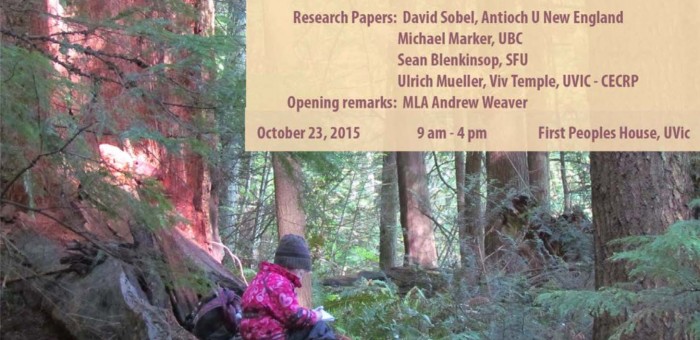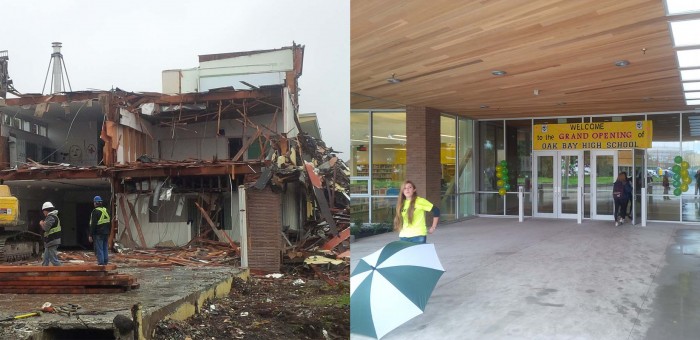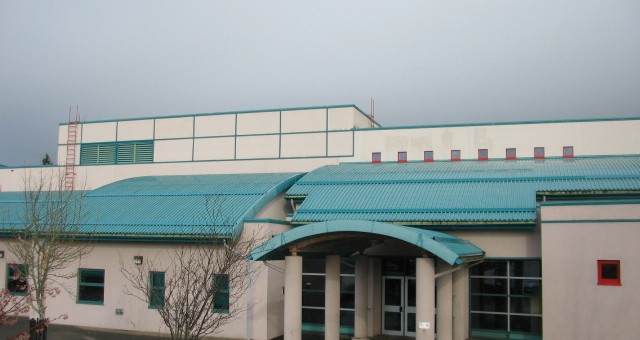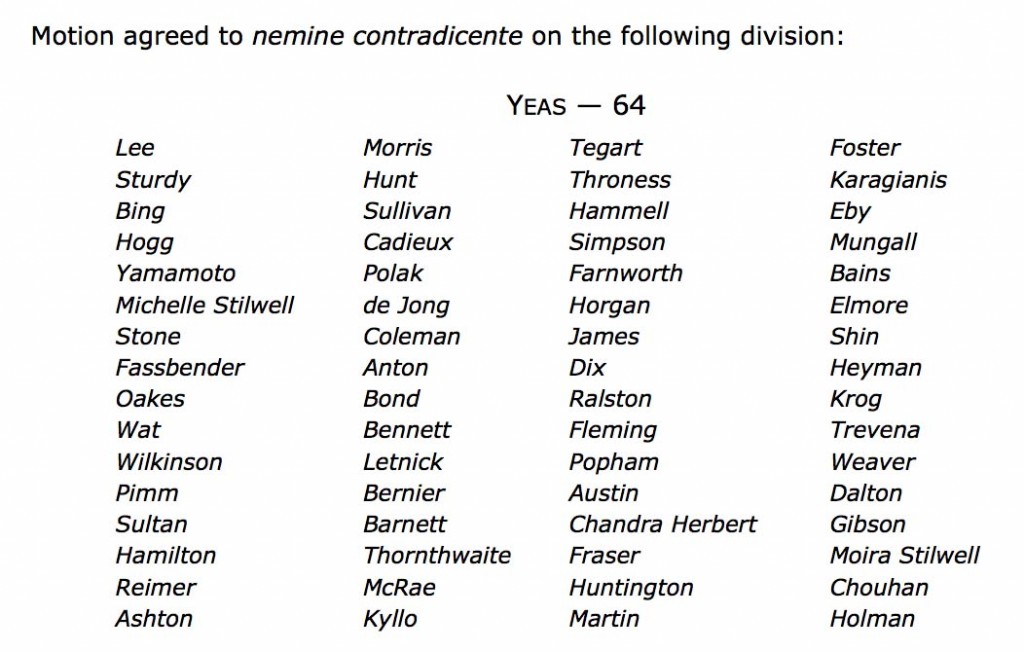K-12 Education
The Wonders of Nature Research Day
Today I was afforded the honour of delivering the opening the opening remarks at the Wonders of Nature Research Day put on by UVic’s Centre for Early Childhood Research and Policy. The research days featured presentations by a number of distinguished scholars including:
- David Sobel, Department of Education, Antioch University, New England
- Michael Marker, Department of Educational Studies, University of British Columbia
- Sean Blenkinsop, Faculty of Education, Simon Fraser University
- Ulrich Mueller, Department of Psychology, University of Victoria
- Viv Temple, School of Exercise Science, Physical and Health Education, University of Victoria
- Enid Elliott, School of Health and Human Services, University of Victoria
Below is the text of my opening remarks.
Text of Opening Remarks
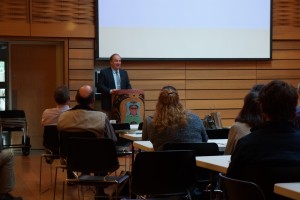 I would like to start off by thanking Beverley and everyone at the Centre for Early Childhood Research and Policy for inviting me here today and for organizing this wonderful conference. As Beverley pointed out, my name is Andrew Weaver and I’m the Member of the Legislative Assembly representing the riding of Oak Bay-Gordon Head — home to the University of Victoria.
I would like to start off by thanking Beverley and everyone at the Centre for Early Childhood Research and Policy for inviting me here today and for organizing this wonderful conference. As Beverley pointed out, my name is Andrew Weaver and I’m the Member of the Legislative Assembly representing the riding of Oak Bay-Gordon Head — home to the University of Victoria.
I have been in the Legislature for about two and a half years now, but before that I actually worked right here at UVic as a Faculty Member in the School of Earth and Ocean Sciences. In parallel with my endeavours in research, I’ve spent a good deal of time engaging the public in discussions about the importance of nature and our environment, and the detrimental path we are headed down if we don’t take action to reduce ongoing loading of the atmosphere with greenhouse gases that are causing global warming.
While it is easy to become disillusioned and worn out working in the field of climate science — seeing the path we’re headed down and fighting an uphill battle to try and make governments and policy makers see it too — it is our children and youth that inspire me — give me hope for the future — and keep me optimistic after so many years in this field.
In fact, one of my favourite parts about my role as MLA, is being able to go into schools and universities and speak to children and youth about our environment and the importance of civic engagement. Seeing their keen interest and appreciation for our natural environment and their desire to make our world a sustainable place is truly what inspires me in my daily work down in the legislature.
Because of this, I was very honoured when I was asked to provide opening remarks here today — I’m just disappointed I won’t be able to stick around to learn about the fantastic research that is being done in this area.
I was actually fortunate enough to experience a nature school program first-hand about a year and a half ago. I was invited by Savory Elementary School to be an “Eco Expert” for their “4 Seasons Eco School”. The program, which I believe was in its inaugural year when I visited, ran each Wednesday and provided all students with the opportunity to learn outside in Savory’s surrounding ecosystem, bringing in a new guest expert each week to guide the children.
I got to spend an entire day, from 8:30 in the morning to 2:30 in the afternoon, delivering a lesson plan to seven separate classes and engaging with every grade from Kindergarten to grade 6. To say that I was exhausted by the end of it would be an understatement, but it was also a truly unforgettable and inspiring experience — and helped to further my respect and appreciation for our teachers who do far more than I did, but on a daily basis.
Over the last decade as a scientist I’ve also had the privilege of working with school districts across Vancouver Island to install more than 150 weather stations on schools (Islandweather.ca for those who are interested), and to develop learning resources, in collaboration with teachers, to allow them to deliver their curriculum using state-of the art instrumentation and an authentic learning experience. Getting out of the ivory tower and into the community to discuss science, weather and our natural environment has been — to be perfectly frank — the single most satisfying and rewarding experience I have had as a scientist.
In today’s technology driven world, where young children are spending as much as eight hours a day interacting with screens — and often less than an hour a day actually outside – I firmly believe that providing children with the opportunity to experience “the wonders of nature” is one of the most important things we can do to help foster their development. While I am by no means an expert in the topic — you will hear from them later — I do know that there is a vast amount of research to demonstrate just how important time spent outdoors is to early development. Studies have shown that children who interact with nature on a daily basis are healthier, happier, more creative and less stressed than those who don’t.
And these benefits are not only felt in childhood. Researchers continue to develop a better understanding of the lasting impacts that early childhood experiences can have on our lives. Whether we remember the experience or not, and whether we are aware of magnitude of those experiences or not, they can stick with us throughout our entire lives. We carry them with us through our adolescent and teen years, into young adulthood and beyond. Developing an understanding and appreciation of nature at an early age will have a lasting effect on children.
And these benefits will not just be felt by the children fortunate enough to experience this type of learning environment. They will be felt by their peers, their families, their communities, and society as a whole. They will impact the way they interact with other people, the way that they view and interact with their environments — both built and natural, and the way that they engage in their future careers.
In a few decades, the children that we’re talking about today will be our teachers, our researchers, our scientists, our policy makers, and our government leaders. They will be making the decisions that influence our society, implementing the policies that protect our environment, and educating an entire future generation of children on the importance of our natural world. So the fact that you are all here today, discussing such an important initiative, is a truly inspiring sight to see!
Thank you again for having me here to speak today and enjoy the rest of the conference!
Celebrating the Opening of the New Oak Bay Secondary School
Today was my turn to read a member’s statement in the house. I took the opportunity to celebrate the grand opening of the new Oak Bay Secondary School.
Statement
Yesterday I, along with the Minister of Education, had the distinct honour of attending the grand opening of the new Oak Bay Secondary School. Four young leaders representing Oak Bay’s four pillars of excellence brought a personal message to the audience, a message building upon comments they received this past spring from alumni who passed them the torch.
Academics was represented by Robert Lee, winner of the 2014 Michael Smith Science Challenge, as Canada’s top grade 10 science student.
Athletics was represented by rugby and track star, Matti Grant.
Fine arts was represented by actress Veronique Beaudet, who performed magnificently as Belle in February’s production of Beauty and the Beast.
Community leadership and philanthropy was represented by Ruby Tang, a leader in her school and outstanding ambassador for youth in so many ways.
Oak Bay Secondary also has a critical and foundational pillar in Mr. Dave Thomson, their principal. Without his tireless efforts to guide the school through the transition from the old to the new, we would not have been in a position to celebrate the successes we did yesterday. Oak Bay Secondary students have a rich history of success in each of its four pillars of excellence.
As an example of leadership, take Ian Cameron, student council president during my 1979 grad year, who is now an ABC news executive producer and married to the U.S. national security advisor, Susan Rice. They are some of President Obama’s favourite dinner guests.
As an example in academics, there’s 1937 Oak Bay grad, Pierre Berton, one of Canada’s most celebrated non-fiction writers and storytellers.
In athletics, Oak Bay has produced several generations of international rugby stars, including Donald Carson, Norm Hadley, Winston Stanley and Mark Wyatt. Our very own Kelly Dukeshire, a security officer in this Legislature, was a much-celebrated national basketball star and a 1978 grad. And in the area of fine arts, Roy Henry Vickers, a household name and distinguished First Nations artist, author and speaker, was a member of the class of 1965.
I want to offer my sincere thanks to all the dedicated teachers, administrators and staff at Oak Bay Secondary School. Collectively, they have contributed so much to the success of their students and the wonderful culture that exists at the school.
I also want to acknowledge, with gratitude, the dedicated school district leadership, my predecessor Ida Chong and this government for their ongoing commitment to build a remarkable new facility — the wonderful, new Oak Bay Secondary School.
Video of Statement
Grand Opening of Oak Bay Secondary School
 Today I had the distinct honour to attend the grand opening of the new Oak Bay Secondary School. Honourable Mike Bernier, British Columbia’s new Education Minister (right), Nils Jensen, Mayor of Oak Bay (right) and I gave brief speeches at the ceremony. Further presentations were given by Deborah Nohr, Trustee in School District 61 and Piet Langstraat, School District 61 Superintendent.
Today I had the distinct honour to attend the grand opening of the new Oak Bay Secondary School. Honourable Mike Bernier, British Columbia’s new Education Minister (right), Nils Jensen, Mayor of Oak Bay (right) and I gave brief speeches at the ceremony. Further presentations were given by Deborah Nohr, Trustee in School District 61 and Piet Langstraat, School District 61 Superintendent.
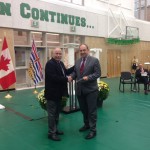 Dave Thomson, principal of Oak Bay Secondary School (left) was the Master of Ceremonies. He also introduced four students, each representing one of Oak Bay’s Pillars of Excellence: Academics (Robert Lee), Athletics (Matti Grant), Fine Arts (Veronique Beaudet) and Community Leadership and Philanthropy (Ruby Tang). These young leaders brought their own personal message to the large crowd – a message building upon comments they received this past spring from Alumni who passed them the torch (signifying a passage from the old school to the new).
Dave Thomson, principal of Oak Bay Secondary School (left) was the Master of Ceremonies. He also introduced four students, each representing one of Oak Bay’s Pillars of Excellence: Academics (Robert Lee), Athletics (Matti Grant), Fine Arts (Veronique Beaudet) and Community Leadership and Philanthropy (Ruby Tang). These young leaders brought their own personal message to the large crowd – a message building upon comments they received this past spring from Alumni who passed them the torch (signifying a passage from the old school to the new).
Of course, while Oak Bay has four Pillars of Excellence from a student perspective, the school has a critical and foundational pillar in Mr. Dave Thomson. Without his tireless effort to guide the school through the transition from the old to the new, we would not have been in a position to celebrate the successes we did today.
Below is the text of my address:
Text of my Speech
Minister Bernier, Mayor Jensen, Distinguished Guests, Principal Thomson, Staff and especially Oak Bay Secondary School Students:
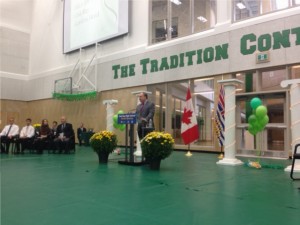 It is a distinct honour for me to be standing here before you as the MLA for Oak Bay Gordon Head. But even more importantly, it’s an honour for me to be here before you as a member of the Oak Bay class of 1979.
It is a distinct honour for me to be standing here before you as the MLA for Oak Bay Gordon Head. But even more importantly, it’s an honour for me to be here before you as a member of the Oak Bay class of 1979.
When I see you, the students in the audience, I see a future full of hope and opportunity. You, the youth of today, are an inspiration to me. Your passion is infectious. Your innovation and creativity fills me with hope. Your desire to make the world a better place through your community leadership is profoundly appreciated. Thank you for all you have done and all that you will continue to do for the betterment of the world around us.
If you are in Grade 9, we’re now in the only Oak Bay Secondary School you will ever know. For the older students, you have been witness to years of construction and upheaval as the new school was being built. It must be extremely exciting to finally transition into your new school.
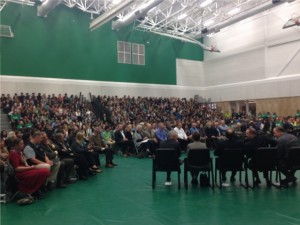 There is so much to be proud of at Oak Bay Secondary. Collectively you have excelled in all your Pillars of Excellence: Academics, Athletics, Fine Arts and Community Leadership and Philanthropy.
There is so much to be proud of at Oak Bay Secondary. Collectively you have excelled in all your Pillars of Excellence: Academics, Athletics, Fine Arts and Community Leadership and Philanthropy.
Let me give you but a few examples. In the area of Leadership, Ian Cameron, student council president during my grad year is now an ABC News executive producer and married to the US National Security Advisor, Susan Rice – they are some of President Obama’s favourite dinner guests. To Academics: At my graduation, Pierre Berton, one of Canada’s most celebrated non-fiction writers and storytellers, and himself a member of the 1937 graduating class, addressed my class of 1979. To Athletics: Donald Carson, Norman Hadley and Mark Wyatt, some of Canada’s most highly regarded rugby stars are all graduates from Oak Bay (around the time I was playing rugby at this school). And to Fine Arts: Roy Henry Vickers, a household name and distinguished First Nations artist, author and speaker whose work can be found around the world was a member of the class of 1965.
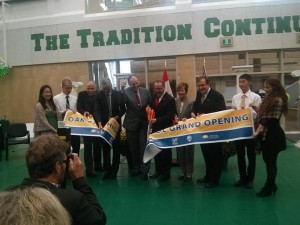 I’ve only mentioned a few former alumni. Their successes could be yours. No, their successes will be yours as you continue your journey whose foundation began with the outstanding education you will receive at this new school.
I’ve only mentioned a few former alumni. Their successes could be yours. No, their successes will be yours as you continue your journey whose foundation began with the outstanding education you will receive at this new school.
I want to offer my sincere thanks to all the dedicated teachers, administrators and staff at Oak Bay – collectively you have contributed so much to the success of the students and the wonderful culture that exists here. I also want to acknowledge with gratitude the dedicated district leadership, my predecessor Ida Chong, and this government for their ongoing commitment to build this remarkable new facility.
Congratulations on the opening of the New Oak Bay High School and thank you for the opportunity to address you today. Enjoy your new school and continue your proud tradition of excellence in whatever path you choose to follow.
Bill 29 – Property Taxation (Exemptions) Statutes Amendment Act
Today in the Legislature I rose to speak in support of Bill 29 – Property Taxation (Exemptions) Statutes Amendment Act, 2015.
Bill 29 ensures that there is consistent treatment across the province with respect to the way independent schools are subjected to municipal property taxation. Presently only the land immediately under a school building is exempt from municipal taxation. While most municipalities extend the exemption to the rest of the school property (playgrounds, playing fields etc.) there have been a few exceptions and some municipalities are contemplating the idea.
Below is the text of my speech at second reading.
Text of 2nd Reading Speech
A. Weaver: It gives me great pleasure to stand and speak in support of Bill 29, Property Taxation (Exemptions) Statutes Amendment Act. My riding is particularly interesting in that there are presently six…. Well, there are five high schools now, but after the election boundaries are redefined, there’ll be six high schools. Three of them are public schools, and three of them are independent schools. Oak Bay, Lambrick, Mount Doug — public schools. St. Michaels and Maria Montessori are presently in the riding and independent schools. Glenlyon Norfolk, soon to be in the riding, as well, is another independent school.
We have much to be proud of, of our education system in British Columbia. Despite what some might have said, Canada ranks at the very top, internationally, in the program for international student assessment scores, particularly in the area of sciences and reading. If we look at the 2012 science rankings, worldwide, No. 1 was Shanghai, China. No. 2, Hong Kong, China. No. 3, Singapore. No. 4, Japan. No. 5, Finland. And No. 6, British Columbia.
Now, when you compare that to 2003, in fact, two of those — Shanghai and Singapore — were not part of the 2003 assessment. So in essence, British Columbia would have been ranked No. 4, worldwide, in terms of science achievement, whereas in 2003, British Columbia was ranked No. 6. So we have much to be proud of in British Columbia with respect to our science education.
The same is true with our language arts. In 2003, No. 1 in the world was Finland. Alberta was No. 2, and British Columbia, No. 3. Since 2002, a number of other jurisdictions have participated in the international PISA. So we see Shanghai and Singapore moving up. British Columbia dropped to No. 6, which would have been fifth if you accounted other jurisdictions that weren’t there.
But what is really important to note is how it did relative to other provinces in Canada and the much-touted Finnish education system. I’ll come to Finland in a second, because in 2003, Finland ranked No. 1 in science, No. 3 in mathematics and No. 1 in reading. British Columbia was sixth in science, fifth in mathematics and third in reading.
Now, what’s indicative of a government that has somewhat lost touch with developing advancements in education, for reasons unknown to anybody, the B.C. government sent a young person to Finland to study the Finnish system. I understand that if you’re looking at the 2003 PISA assessments, you might want to understand the Finnish system. But in 2012, British Columbia was above Finland in mathematics, was above Finland in reading and was tied, statistically so, in science. There’s much to be proud of about our education system in British Columbia, and we do not need to study the Finnish system to find that out.
We are the top-ranked province in Canada, in terms of science education as well as reading, and yet that was not the case in 2003. Alberta was the top-ranked province in all three areas covered by PISA. But there is one area that B.C. does have some trouble with and I would argue that this has nothing to do with the quality of our teachers in British Columbia, but rather as the quality of the means and the ways they’re being trained to teach mathematics.
Mathematics is the one subject where B.C. has dropped, relative to other jurisdictions, in the move that has moved mathematics from learning the times tables by rote memorizing — learning by memorization, a critical aspect of learning mathematics — and moving into trying to understand what that means. You should know that seven times eight is 56, right off the bat. That’s a critical building block. But you shouldn’t necessarily have to know in grade 3 that….
M. Farnworth: Nine times seven?
A. Weaver: Sixty-three, and nine times nine is 81.
But today in school you’re not taught nine times seven is 63. You’re taught that nine times seven is ten times seven minus one times seven. Now, that’s an abstract idea that many people in elementary education simply can’t grasp. If you want to know why we’re going down in maths, you have only to look at the way our teachers are being trained in the universities, not the quality of the teachers themselves. Apart from mathematics, we rank at the very top internationally.
I will not listen to those who bemoan the state of our education system in B.C. We rank second to no other province in terms of quality, and we’re one of the top nations internationally and certainly the top nation in the western hemisphere.
What does that have to do with the bill? Well, it has to do with treating independent schools the same as public schools. Presently, the contents of this bill are actually in play in the Vancouver Charter already. The Vancouver Charter is quite specific in terms of what can or cannot be included in property taxation. This bill essentially says to the rest of the province that we’re going to be consistent. Whether you be in Victoria, Prince George, Kelowna, whether you be in Fernie, whether you be in Haida Gwaii, Prince Rupert, schools will be treated one and the same in terms of their property taxation.
Many people often don’t realize that we’ve had independent schools in Canada since the 17th century when the first Catholic schools were established in Quebec. In many jurisdictions, we have publicly funded school boards that fall along denominational lines. In Ontario and Alberta, for example, we have Catholic school boards and we have non-Catholic school boards. They’re both public school systems that go back to Confederation days. Here in B.C., we would call Catholic schools independent schools, where in other provinces, they’re considered part of the public system.
We have other potential problems which exist presently. Let’s suppose right now that we have a Catholic school on church property. How does that fall within the property taxation realm? Is it a church? Is it an independent school? Is it in the Catholic school board? No. This needs to be cleared up. While this bill is very short in terms of length, it’s important in terms of substance, because it actually closes a lot of potential problems that could create a potpourri of odd property taxations across the province.
One of the things that I support in this bill is the fact that it does not apply to things like endowment lands, things like houses for staff, for example, if there may be some independent schools that provide housing for their teachers. There may be some other independent schools that have large endowment lands. These are not being covered under this legislation. It’s simply the school and that which is typically used in school.
There are benefits for that. A school in my riding, Glenlyon — well, soon to be my riding; half the school is in my riding — for example, has a lovely Astro Turf field that is used by the local community in partnership, the Bays United soccer community. They have a public relationship with the independent school, yet there is a potential — it’s not right now — for that to be taxed, even though the public is benefiting from this field that is used by all.
In summary, then, first off I would like to recognize that we do have an outstanding education system. It does not help our education system when we continue to bemoan the problems in it instead of celebrating the successes in it. Sure, there are problems in our education system. There are problems in everything around us. But we will not move this education system forward if all we do is fixate on the negative that’s in it.
Secondly, I think fairness is critical. This bill provides fairness, recognizing that there are other provinces where independent schools, like the Catholic system, are actually part of the public system, whereas in B.C. we’ve never had Catholic school boards. Finally, it does not exclude some of the extraneous properties attached with an independent school. Those will be subject to municipal taxes.
With that, I thank you for your time. I’m only sad that the new Minister of Education is no longer sitting beside me, but across the hall. I do appreciate your office, hon. Speaker, and of those House Leaders, in preparing me here in the Legislature for two upcoming by-elections so that my colleagues can sit beside me.
Video of 2nd Reading Speech
The Vote
Second reading of Bill 29 approved unanimously on a division.
Bill 11: Education Statutes Amendment Act, 2015
For the foreseeable future, it seems likely that British Columbians will have to watch as the decades long dance of dysfunction between the BC Government and the BCTF continues to play out.
The most recent iteration of this is taking place in the Legislature this week as we debate Bill 11 – The Education Statutes Amendment Act.
Sadly, with the introduction of this Bill we’ve missed out on an incredible opportunity for British Columbians to come together through an engaging discussion about how we might improve our education system.
In introducing Bill 11, yet another opportunity to rebuild the relationship between teachers and government has been squandered. The Bill unilaterally allows government control over the professional development of teachers, and empowers government to issue directives to school boards that they would be bound to follow.
I want to be clear – I welcome a conversation about reforms to our public education system. We need to be willing to discuss controversial topics like re-examining the role school boards play in a modern education system and whether a decade of corporate and personal income tax cuts have gone too far.
However, these much needed conversations can only take place when all those involved demonstrate a commitment to their relationship with one another, and actively seek to build mutual trust and understanding. And while Bill 11 is only the most recent example of governments role in damaging this relationship, the BCTF is not without responsibility. Earlier this year the BCTF invited the Leader of the BC NDP to address their 2015 AGM in a partisan speech that ended with him calling on everyone to defeat the BC Liberals. This does nothing to build bridges. Rather, it further deepens the partisan divide and everyone loses when that happens.
It is easy to forget that amidst all these issues, British Columbia is home to outstanding teachers and a world renowned education system. We should be celebrating our successes and supporting the good work being done by teachers in our province.
Bill 11 is a poorly thought out piece of legislation that deserved a far more rigorous and substantial public consultation so that we could have the conversation about public education that we need. I will not be supporting its passage and will continue to work to establish a different way forward on public education.
A full copy of my remarks can be found below.
Video of Second Reading Speech
Transcript of Second Reading Speech
To begin, I’d like to emphasize that I’ve always believed that teaching is the single most important profession in our society. Each and every one of us has attended school, and that experience has shaped who we are, what we do, and how we contribute to society. So it follows that public education represents perhaps the most important investment government can make for the prosperity of our province.
Public education is absolutely critical in teaching the next generation of British Columbians to think critically, contribute responsibly to society and to become the leaders of tomorrow.
Teaching is a thoroughly rewarding, yet physically and emotionally exhausting profession. It takes a very special person to be able to instruct a class of 20 to 30 young children for five hours every day. Last year I spent a day engaging every grade from kindergarten to grade six at Savory Elementary’s Four Seasons Eco-School (4EST) program.
I only had one lesson plan to deliver to the seven separate classes, from 8:45 to 2:30 on that day. I had no marking to take home, no report cards to write, no parents to interact with, no staff meetings and no administrative activities. Nor did I have to take the students on extracurricular activities. But let me tell you that I was exhausted at the end of the day. And I only did that once, not day in, day out, for months on end.
Let me start my speech by noting that we have outstanding teachers and an exceptional education system in the province of British Columbia. Every three years the Programme for International Student Assessment, known as PISA, evaluates the performance of students internationally in three subject areas: mathematics, science and reading.
The Council of Ministers of Education, Canada further breaks down the Canadian results on a province-by-province basis. British Columbia consistently performs extremely well. In 2012, for example, British Columbia was the top Canadian province in reading and science and was second only to Quebec in mathematics.
In fact, British Columbia students even performed better than students from the much-touted education system in Finland in both reading and mathematics. And while Finland scored slightly ahead of B.C. in science, the difference was statistically insignificant. Of course, we’ll have to wait until December 2016 to get the PISA 2015 results to see how British Columbia continues to fare.
Now, I recognize that the PISA results only provide one metric of student achievement and, hence, the success of the British Columbia school system. Nevertheless, it’s a very positive one. It says to me that we must be doing something right in British Columbia despite what we might read about in the news. It also suggests to me that maybe we should start to celebrate our successes and dwell less on the negative arising from a dysfunctional relationship between the B.C. government and the BCTF.
At the end of the strike last fall the government spoke about “an historic six-year agreement…which means five years of labour peace ahead of us.” Rather than viewing this as five years of simmering anger waiting to boil over when the negotiations next begin, we should be capitalizing on this time to envision bold new ways of ensuring our educational system is sustainable.
This includes teachers being fairly compensated and adequately supported with properly funded curriculum and learning resources. Such support must include sincere and meaningful class size and composition discussions and support that recognizes that teacher burnout affects us all. It must include reinvigorating our educational infrastructure and ensuring that children have textbooks and access to learning materials.
On Thursday the B.C. Court of Appeal will release its decision concerning the rights of teachers to negotiate conditions around class size and composition. Rather than allowing this to serve as a catalyst to incite increased tension between the BCTF and the government, perhaps both parties will recognize the opportunities that will arise from mutual collaboration, no matter what the Court of Appeals decision is.
For example, perhaps there is a compromise on class size and composition negotiations. Why don’t the BCTF and the B.C. government both agree, for example, that the best place to negotiate class size and composition is at the local school district level?
In fact, as noted in the book Worlds Apart: British Columbia Schools, Politics and Labour Relations Before and After 1972 by Thomas Fleming, the BCTF was not pleased with the 1994 Public Education Labour Relations Act which led to the formation of BCPSEA and the BCTF being appointed as the official bargainer for all teachers.
Provincial data clearly show that one size does not fit all. The class-size and composition needs of Haida Gwaii school district 50 are almost certainly different from those in the Gulf Islands, No. 64, or Surrey, school district 36.
Perhaps both parties would consider waiving the right to strike in favour of binding arbitration with respect to salary and benefit negotiations. In 1950 Manitoba teachers did just this. In return, they gained binding arbitration, due process and a provincial certification board. There has been labour peace in Manitoba ever since.
Binding arbitration forces each party to come up with their best offer. The arbitrator then chooses from one of them or some combination of both. One thing is certain. Outlandish requests are taken off the table quickly when binding arbitration is in play.
While the B.C. government and the BCTF play out their decades-long dance of dysfunction as they battle it out, entrenched in what I perceive to be ideological positions, the ones who are paying the price are the children in the classroom, the teachers who teach them, and their parents at home.
But moving this relationship forward requires trust, mutual trust. It’s easy for me to see why the BCTF and other stakeholders in public education are leery to trust the direction this government is taking in Bill 11. This bill is a classic example of putting the cart before the horse. Rather than engaging education stakeholders in meaningful dialogue, the government is providing itself with rather sweeping powers to appoint special advisers and issue administrative directives. Nobody knows what the minister has in mind or what cabinet will do with these powers, should this law receive royal assent.
Bill 11 repeals the concept of school planning councils. Frankly, I support moving back to focusing the parent’s role in the parent advisory councils. The B.C. Liberals school planning council model was a failed approach to school-based governance, introduced when our current Premier was the Minister of Education.
I doubt that there will be much public outcry over this, although it would have been preferable to give the public more opportunity for input prior to actually putting this legislation forward. After all, this is public education that we are discussing here today.
Bill 11 takes the very provocative and, honestly, I think, ill-thought-out position of empowering the minister to set teachers’ professional development requirements. Like any profession, teachers require ongoing professional development. That goes without saying. But like these same professions, professional development must be led by the experts. In this case it’s by the teachers, not by ministerial decree.
Now, I recognize that the minister will say and respond that he wants to negotiate with the BCTF as to what this professional development might look like. However, my reply to the minister on this is that he’s lost trust. He’s lost the trust of the teachers, as what the minister had in mind should have been conveyed prior to, rather than after, this legislation being tabled.
Besides, what body would oversee the professional development? The B.C. College of Teachers would have been the natural place, but it’s been disbanded. The BCTF is a union tasked with representing its members in negotiations, not in maintaining professional standards. So they are not the appropriate home for such professional ongoing professional development.
The teacher regulation branch doesn’t seem the right place either. So what does the minister have in mind? We simply don’t know, and therein lies the problem. Why are we bringing forward legislation to discuss this when we do not know what the minister has in mind and when trust has been broken and lost with negotiations on this topic with the teachers before we’ve even started to discuss it?
It’s clear to me that this bill was not ready for debate in the Legislature. In my view, it should have followed the lead of the Society Act or the Water Sustainability Act and allowed extensive public consultation prior to its introduction, rather than afterwards.
Both of those pieces of legislation obtained a social licence, public support. In the case of the Society Act, public input led to a better act, with the removal of section 99. But here we do not have public support. We’ve just come off a prolonged strike, and on Thursday the B.C. Court of Appeal will release its long-awaited decision.
What an incredible opportunity this could be for British Columbians to be offered to come together through an engaging discussion about how we might improve our education system.
Instead of discussing this ill-thought-out legislation whose direction is not actually brought forward with any substance today for us to speak to, we could have had a discussion about education. For example, we could have had a discussion about education funding.
The level of funding allocated to our public education system depends on the priorities of the government. In British Columbia spending on health care has remained a priority since 2000, ranging between 7 percent and 8 percent of provincial GDP. Funding for social services and education expressed as a percentage of GDP, on the other hand, has dropped over this period of time.
In the case of education funding as a percentage of provincial GDP, it has declined from a high of about 6.4 percent in 2001-2002, when the Liberals took office first, to an estimated low of about 5 percent in 2014-2015. Now, that’s a 22 percent decline in the percentage of funding, as a percentage of GDP, being spent on education in our province.
If British Columbians deem education to be as important as I do, surely this drop needs to be rectified. So the question is: where does this money come from? I would argue that British Columbians need to have a hard look at our sources of provincial revenue and the way we spend the money that government receives. Given a decade of corporate and personal income tax cuts, perhaps it’s time to take a look at whether or not we’ve gone too far.
That’s an important discussion to have, as it ultimately affects the availability of funds for our public education system. That’s a discussion we could have had prior to the introduction of Bill 11. With increases in public school enrolment looming, it’s critical that we initiate this discussion now, not later, not tomorrow, not after the next settlement is in negotiation with the teachers in our province.
We could have had a discussion about the ongoing role of the B.C. Public School Employers Association. The BCPSEA was established in 1994. Since that time there has been a continued escalation of conflict between the BCTF and the government via BCPSEA. Perhaps it’s time to consider dismantling BCPSEA and, instead, bringing its operations directly into the Ministry of Education. This would signal that government is willing to start afresh to try and build a new relationship with teachers. After all, it’s the government, not BCPSEA, that holds the purse strings.
We could have engaged in a discussion about the role of school boards in our public education system. Thomas Fleming, in his aforementioned book, noted:
“A history of extremely low voter turnout in school board elections, along with the influence of teacher associations over electoral candidates, has raised serious questions about whether boards in fact actually reflect the public’s educational will or simply serve as a platform for the expression of various special interests — all insistent on greater school spending, regardless of other legitimate public demands government is obligated to consider.”
That quote comes from page 109.
He further points out that only between 5 percent and 10 percent of eligible voters turn up at a school board election not occurring at the same time as municipal elections. In addition, he detailed a by-election in the capital regional district that brought out around only 2 percent of the electorate.
The mandate of school boards has changed over the last century. In the early 20th century local school boards were tasked with hiring the teacher for their often one-room schoolhouse in rural areas, for example, and ensuring that the school was kept up. Provincial inspectors toured the province to make sure that centrally determined educational standards were maintained.
In an extremely influential report authored by Max Cameron in 1946, sweeping changes were proposed to the previously existing model of public school governance. Increased financial efficiency and equitable educational opportunities for all rural and urban British Columbian students required a new approach.
In 1944 there were 650 school districts governed by 437 school boards. Just three years later only 89 school districts remained, and by 1971 this was down to 74. Today there are 60 school districts. Is that the right number? Should their mandate be changed? These are questions the public should have had a chance to discuss and become engaged on discussing prior to the introduction of Bill 11.
We could have engaged in a discussion about whether British Columbians want to follow the New Zealand model, where school boards were eliminated in their entirety, or the Finnish model, where school districts are aligned more closely and intimately with local municipalities for funding, or some other variant.
We could have engaged in a discussion about teacher shortages that will emerge in a few years as projected enrolment increases. All school-aged demographics are expected to rise for at least the next decade. This further suggests that while we may have an excess of teachers being trained today, in three or four years, as the teacher demographic ages and as the number of school-aged children starts to increase, we will almost certainly have teacher shortages, particularly in the areas of French immersion, mathematics and science, where demand exceeds supply even presently.
Rather than perpetuate the boom-and-bust cycle of teacher training and hiring and rather than keeping people for many years on the teacher-on-call list, perhaps a more gradual transition to full-time employment could have been developed. Perhaps we could be discussing this as many of the things in our education system that we could and should have been discussing prior to the introduction of Bill 11.
For example, teacher burnout early on in one’s career is not uncommon. We all know an example of a teacher or two who taught for a few years and moved on, as the requirements placed upon them are simply unbearable, given the support that is lacking at their early age of entry into the teaching profession.
A young teacher might be thrown into a new situation, with multiple class preparations for a range of students with a diversity of skills and backgrounds, with no past teaching material practices to draw upon. New teachers can quickly become overwhelmed with workload. Senior teachers, on the other hand, approaching retirement have a wealth of experience, curriculum resources and best practices. Perhaps it’s possible to negotiate a buddy system, where a retiring teacher signs an agreement to retire gradually over, say, a three-year period, and during that time the starting teacher is paired with the retiring teacher. While the senior teacher gently eases into retirement, the new teacher gently eases into full-time teaching, and the decades of experiences and best practices are passed along from the senior to the junior teacher.
Finally, perhaps we could have started a discussion about innovative ways that would allow school districts to build upon best practices of shared services prior to the introduction of this bill that we are discussing today. Perhaps the government could play a role here and provide the province with a centralized payroll system or legal services, for example. Does each district need to have its own payroll department? Should teachers be employed by the Ministry of Education instead of the board? Are there opportunities for economies of scale?
Bill 11 enables the minister to step in, but again, it would have been preferable to open the bill up first for public and stakeholder input prior to tabling it in this House.
Now, those ideas that I’ve put forward are not any ones that I’m advocating for particularly, or any at all. I’m simply introducing them and putting out these ideas in the hope that they provoke a discussion, a discussion about how public education should evolve in British Columbia. Unfortunately, the approach to educational policy change in the province of British Columbia is viewed by many — by parents, by teachers, by others — in the province as heavy-handed and top down.
Building a social licence for change requires uncomfortable topics to be discussed and new ideas also to be discussed. Sadly, rather than introducing this legislation after such discussions were conducted and concluded, the legislation was brought forward prematurely, and in doing so government sends the wrong message to teachers.
It sends a message that suggests the heavy handed, top-down, rather than collaborative, approach to educational reform is the direction this government is heading.
But please let me reiterate. The status quo between the government and the BCTF cannot continue. The politicization of our public education system serves no constructive purpose. We have outstanding and dedicated teachers in the province of British Columbia. We have a very educated workforce, and we can use it to attract business to our province, as we offer something no one else in the world has — bountiful natural resources and the most beautiful place on earth as our backyard.
Now, the politicization of our public education system is not just the fault of the government. When the BCTF invites the leader of the B.C. NDP to address the 2015 AGM in a partisan speech that ends with him calling on everyone to defeat the B.C. Liberals, which he referred to as “those buggers,” this does nothing to build bridges between teachers and government. It does nothing to build trust in the province of British Columbia. Rather, it further deepens the partisan divide, and everybody loses when that happens. Our children lose, their teachers lose and the parents of those children also lose when public education in the province of British Columbia becomes partisan.
Let’s step back. Let’s let this bill die on the order paper and reintroduce it next year, once a more thorough consultation process has occurred. Let’s get it right, so that we can start rebuilding trust between teachers and government in British Columbia.

